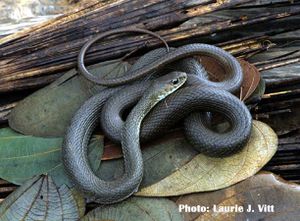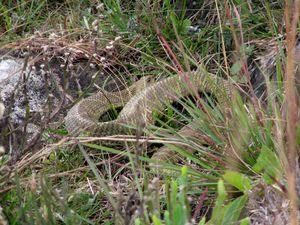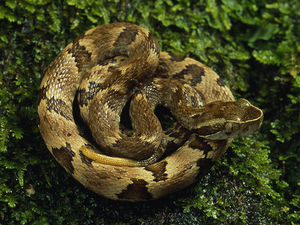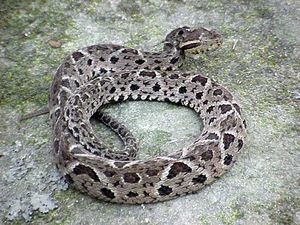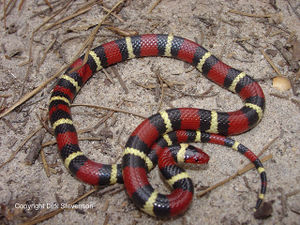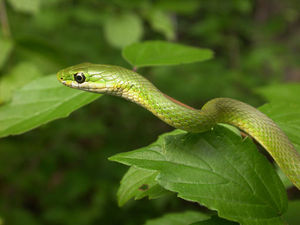Difference between revisions of "Snakes"
(→Cotiara) |
(→Flame snake: File:Adult Rhombifer.jpg) |
||
| (5 intermediate revisions by the same user not shown) | |||
| Line 2: | Line 2: | ||
But even the [[W:Black mamba|black mamba]] which is the fastest, most poisonous and most aggressive snake in the world is actually a shy and secretive creature by nature. It always seeks to escape when a confrontation occurs, unless cornered, in which case the black mamba can put up a fearsome display of defense and aggression. | But even the [[W:Black mamba|black mamba]] which is the fastest, most poisonous and most aggressive snake in the world is actually a shy and secretive creature by nature. It always seeks to escape when a confrontation occurs, unless cornered, in which case the black mamba can put up a fearsome display of defense and aggression. | ||
| + | |||
| + | == Philodryas == | ||
| + | [[File:Philodryas patagoniensis.jpg|right|300px]]This is the first kind of snake I saw on our land. It was about a metre long and an inch thick. They can have a venomous bit, but it is only very mild and nor permanently harmful to humans. | ||
| + | <div style="clear:both"></div> | ||
== Cotiara == | == Cotiara == | ||
| Line 23: | Line 27: | ||
== Coral snake == | == Coral snake == | ||
| − | [[File:Coral Snake.gif|right]] Coral snakes are very poisonous, but are also extremely shy and will escape quickly from any rapid movement or loud noise, they will only attack a human as an absolute last option, so the basic rule when encountering a Coral snake is simply to give it room to get away easily. Coral snakes only accounted for 0.65% of the 75312 bites by venomous snakes in Brazil between 2001 and 2004. | + | [[File:Coral Snake.gif|right|300px]] Coral snakes are very poisonous, but are also extremely shy and will escape quickly from any rapid movement or loud noise, they will only attack a human as an absolute last option, so the basic rule when encountering a Coral snake is simply to give it room to get away easily. Coral snakes only accounted for 0.65% of the 75312 bites by venomous snakes in Brazil between 2001 and 2004. |
If you are bitten by a Coral snake then a couple of important things to note are firstly that their poison is injected into the victim quite slowly taking up to five seconds, so pulling the snake off quickly and throwing it away can greatly reduce the amount of poison that enters the body. Secondly, the poison takes a few hours or more to begin taking effect, so you have plenty of time to get to a hospital, but make it a top priority because once the venom starts to take effect, it can prevent you from breathing. | If you are bitten by a Coral snake then a couple of important things to note are firstly that their poison is injected into the victim quite slowly taking up to five seconds, so pulling the snake off quickly and throwing it away can greatly reduce the amount of poison that enters the body. Secondly, the poison takes a few hours or more to begin taking effect, so you have plenty of time to get to a hospital, but make it a top priority because once the venom starts to take effect, it can prevent you from breathing. | ||
| Line 31: | Line 35: | ||
They're limited to southeastern and south-central Brazil and found mainly in deciduous subtropical and tropical forests, cerrado savannas, and scrub-palm associations; from near sea level to about 600m elevation. | They're limited to southeastern and south-central Brazil and found mainly in deciduous subtropical and tropical forests, cerrado savannas, and scrub-palm associations; from near sea level to about 600m elevation. | ||
| − | == | + | One important note is that the famous rule "red then black, friend of Jack, red then yellow, kill a fellow" only applies to North America. In Brazil there are many species of Coral that are venomous but do not have any yellow colouring at all, but there are also species of "false corals" as well such as [[w:Oxyrhopus guibei|Oxyrhopus guibei]]. Beth saw a coral in our vege patch, but we couldn't get a photo of it and we don't know whether it was a venomous species or not. |
| − | + | ||
| − | + | == Flame snake == | |
| + | The flame snake is a "false coral". In May 2015 we saw a baby one (about 30cm long) just outside the door looking at my dog slippers :-) I got a pretty clear photo of it which allowed us to identify it as ''Oxyrhopus rhombifer rhombifer'', but unfortunately we found very little information about it. From the little information we did get it seems that it's a non-venomous and quite tame species. They eat insects and small lizards which you can see in [https://www.youtube.com/watch?v=oXtfhjEZpYs this video]. In March 2017 I saw an adult one about a meter long where the road enters our forest. | ||
| + | {{table | ||
| + | |[[File:Tiny snake by the door.jpg|300px]] | ||
| + | |[[File:Adult Rhombifer.jpg|300px]] | ||
| + | }} | ||
| + | |||
| + | == Grass snakes == | ||
| + | [[File:Green grass snake.jpg|right|300px]]We've seen a number of different coloured snakes which I'm just putting into the general category of "grass snake" until we know more, some have been light brown to hide in piles of dead grass, others a darker grey with blackish stripes. They can grow over a metre long but are only a centimetre or so thick. | ||
| + | <div style="clear:both"></div> | ||
| + | |||
| + | == Possible rattle snake == | ||
| + | Beth saw some kind of snake that made some kind of rattle-snake noise, but she didn't notice if it had a rattler on the end. She can't remember enough details for us to find out what it may have been, but I'm adding this note anyway for now. | ||
== See also == | == See also == | ||
| + | *[http://reptile-database.reptarium.cz/advanced_search?taxon=snakes&location=Rio+Grande+do+Sul&exact%5B0%5D=taxon&exact%5B1%5D=location&submit=Search Snakes in Rio Grande do Sul listed in the Reptile Database] | ||
| + | *[http://www.hyderabadzoo.in/hz/template/Hyderabadi_Friends_of_Animals/Friends_of_Snakes_Society Friends of Snakes Society] | ||
| + | *[http://top10hm.com/top-10-deadly-snakes/ Top-10 Deadly Snakes] | ||
*[http://www.hyderabadzoo.in/hz/template/Hyderabadi_Friends_of_Animals/Friends_of_Snakes_Society Friends of Snakes Society] | *[http://www.hyderabadzoo.in/hz/template/Hyderabadi_Friends_of_Animals/Friends_of_Snakes_Society Friends of Snakes Society] | ||
[[Category:Land]] | [[Category:Land]] | ||
Latest revision as of 16:57, 10 March 2017
We have snakes on our land, so I'd like to start a list of the possible kinds we may encounter and which are dangerous. Although deadly, snakes play an important role in the proper functioning of our ecosystems. Most reported cases of snake bites occur when the human unknowingly steps on or disturbs the snake. Snakes are generally a shy species with very few types having a really bad temper.
But even the black mamba which is the fastest, most poisonous and most aggressive snake in the world is actually a shy and secretive creature by nature. It always seeks to escape when a confrontation occurs, unless cornered, in which case the black mamba can put up a fearsome display of defense and aggression.
Contents
Philodryas
This is the first kind of snake I saw on our land. It was about a metre long and an inch thick. They can have a venomous bit, but it is only very mild and nor permanently harmful to humans.
Cotiara
This is the second snake I've seen on our land, and the first I was able to take my own photo of.
Jararaca
One of these was found on our land not long ago. They're often confused with Terciopelo, but those are only found in central America. The Jararaca, literally meaning “large snakes”, comes in a variety of colours and has golden eyes. This Pit Viper species is found in Southern America only, and are usually found in open areas such as farmlands and near rivers from near sea level to over 1,000m altitude.
25mg venom is injected in the victim on biting which is less than fatal for most humans but quite deadly for lesser weighting animals. Internal bleeding can occur due to its bite along with brain haemorrhage. It was responsible for 52% (3,446 cases) of snakebite between 1902 and 1945, with a 0.7% mortality rate (25 deaths). The average venom yield is 25-26mg with a maximum of 300mg of dried venom. The venom is quite toxic. The median lethal dose is estimated to be about 200mg subcutaneous.
The Jararaca grows to a maximum length of 1.6m, although the average length is much less. The head scalation includes 5-12 intersupraoculars that are weakly keeled, 7-9 supralabials (usually 8) of which the second is fused with the prelacunal to form a lacunolabial, and 9-13 sublabials (usually 10-12). Midbody, there are 20-27 dorsal scales (usually 23-25). The ventrals number 170-216 (rarely 218) and the 51-71 subcaudals are mostly paired.
The colour pattern is extremely variable, consisting of a dorsal ground colour that may be tan, brown, gray, yellow, olive, or almost maroon. Midbody, this colour is usually somewhat lighter than the head, anterior and posterior. This is overlaid with a series of pale-edged, dark brown subtriangular or trapezoidal markings on either side of the body, the apices of which reach the vertebral line. These marking may be situated opposite each other, or partially or completely juxtaposed; most specimens have a pattern with all three variations. In juveniles, the tip of the tail is white.
The head has a prominent, dark brown stripe that runs from behind the eye on either side of the head back to the angle of the mouth, usually touching the last three supralabials. Dorsally, this stripe is bordered by a distinct pale area. The tongue is black and the iris is gold to greenish gold with slightly darker reticulations.
Jararacuçu (a.k.a Urutu)
The Jararacussu is a type of a Pit viper found mostly in South America. It has almost 1000mg venom in its poisonous fangs at a time of which up to 300mg can be transferred in a single bite! Bites by juvenile Jararacussu snakes lead to coagulation of blood but larger ones cause instant death of all cells which come in contact with the poison and bleed from the bite as well as other areas.
Coral snake
Coral snakes are very poisonous, but are also extremely shy and will escape quickly from any rapid movement or loud noise, they will only attack a human as an absolute last option, so the basic rule when encountering a Coral snake is simply to give it room to get away easily. Coral snakes only accounted for 0.65% of the 75312 bites by venomous snakes in Brazil between 2001 and 2004.
If you are bitten by a Coral snake then a couple of important things to note are firstly that their poison is injected into the victim quite slowly taking up to five seconds, so pulling the snake off quickly and throwing it away can greatly reduce the amount of poison that enters the body. Secondly, the poison takes a few hours or more to begin taking effect, so you have plenty of time to get to a hospital, but make it a top priority because once the venom starts to take effect, it can prevent you from breathing.
Adult Coral snakes are usually 65 to 85cm long, but can be up to 1.5m. They have a reddish body with 11-14 triads of black rings, tail short (with less than 2 full triads). Snout and chin white (usually with scales edged with black; and often with black spots), head with wide red band around middle. Dorsal junctions of red and black rings looks "jagged" because scale tend to be all red or all black. One pair of fixed, upper, front fangs.
They're limited to southeastern and south-central Brazil and found mainly in deciduous subtropical and tropical forests, cerrado savannas, and scrub-palm associations; from near sea level to about 600m elevation.
One important note is that the famous rule "red then black, friend of Jack, red then yellow, kill a fellow" only applies to North America. In Brazil there are many species of Coral that are venomous but do not have any yellow colouring at all, but there are also species of "false corals" as well such as Oxyrhopus guibei. Beth saw a coral in our vege patch, but we couldn't get a photo of it and we don't know whether it was a venomous species or not.
Flame snake
The flame snake is a "false coral". In May 2015 we saw a baby one (about 30cm long) just outside the door looking at my dog slippers :-) I got a pretty clear photo of it which allowed us to identify it as Oxyrhopus rhombifer rhombifer, but unfortunately we found very little information about it. From the little information we did get it seems that it's a non-venomous and quite tame species. They eat insects and small lizards which you can see in this video. In March 2017 I saw an adult one about a meter long where the road enters our forest.
Grass snakes
We've seen a number of different coloured snakes which I'm just putting into the general category of "grass snake" until we know more, some have been light brown to hide in piles of dead grass, others a darker grey with blackish stripes. They can grow over a metre long but are only a centimetre or so thick.
Possible rattle snake
Beth saw some kind of snake that made some kind of rattle-snake noise, but she didn't notice if it had a rattler on the end. She can't remember enough details for us to find out what it may have been, but I'm adding this note anyway for now.
